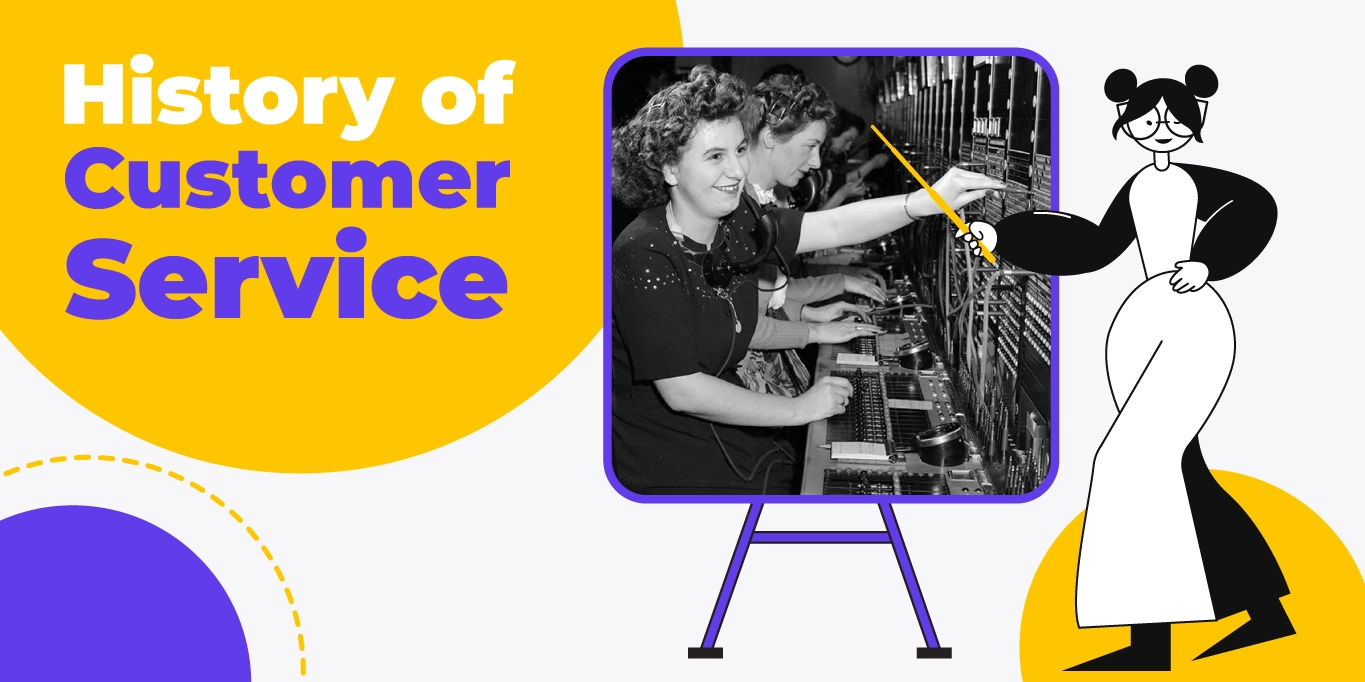History of Customer Service: How Did It All Begin?
• Customer Support
• FastBank

The history of customer service stretches back thousands of years, evolving alongside trade and commerce. From the earliest forms of trade in 3000 BC to today's digital customer support, the evolution of customer service has been shaped by innovation, technology, and consumer expectations.
The development of customer service history as we know it today was officially set in motion in the 1760s after the Industrial Revolution, marking the beginning of what we now refer to as the customer service revolution. Let's take a deeper look at how customer history has unfolded over time.
Who Invented Customer Service?
Customer service history is defined as the direct interaction between a consumer and a representative of the company selling a product or service. While there's no official record of who invented the term "customer service," its roots are likely traced back to the growth of trade and business practices over time.
One significant event in customer service history was the invention of the telephone by Alexander Graham Bell in 1876, which dramatically impacted communication and customer relations. However, customer service, in its early form, predates this invention by centuries.
Stage 1: The Beginnings – Face-To-Face Service
In the early stages of customer service history, all interactions were conducted in person. With no advanced technology available, customers had to communicate with merchants face-to-face or through written letters, which often resulted in delays.
The First Industrial Revolution, spanning from 1760 to 1820, brought transformative economic changes across Europe and America. As factories emerged and demand for goods grew, businesses formed the first customer service teams to address consumer needs. During this period, face-to-face communication remained the most efficient and practical method of support.
In 1776, Adam Smith's influential work, The Wealth of Nations, emphasized the rise of capitalism and competition in the marketplace, laying the foundation for a more customer-focused business approach.
By 1868, a door-to-door salesman named Watkins Liniment introduced one of the first money-back guarantees, marking a significant milestone in the shift toward improved customer service and consumer trust.
Stage 2: The Invention of the Telephone
The next major development in the evolution of customer service came with the invention of the telephone. This revolutionary device drastically increased the efficiency and reach of customer support, fueling the customer service revolution by enabling businesses to connect with customers instantly.
In 1876, Alexander Graham Bell's groundbreaking invention of the telephone changed communication forever. Businesses quickly adopted telephone technology, making it a primary method of customer support. By 1894, the introduction of the telephone switchboard further enhanced accessibility, allowing companies to communicate with customers more seamlessly. As telephone use expanded, the 1960s saw the emergence of dedicated call centers where agents could answer customer queries and resolve issues more efficiently.
In 1967, AT&T introduced the 1-800 number, a significant advancement that simplified communication and reduced costs for both businesses and consumers. The 1970s brought further innovation with the introduction of Interactive Voice Response (IVR), which enabled customers to interact with automated systems that directed their calls to the appropriate representatives.
Stage 3: The Internet and E-Commerce Era
The late 20th century saw another transformation in customer history with the rise of the Internet, which provided businesses with new ways to engage with their customers and enhance service offerings. Although the internet had been developed in the 1980s, it was during the 1990s that it gained widespread adoption, prompting companies to establish an online presence. This digital shift facilitated easier customer interactions through websites and email correspondence.
In 1992, President George H. W. Bush officially recognized the growing significance of customer service by declaring Customer Service Week, highlighting the essential role of quality service in business success. The mid-1990s marked the emergence of e-commerce giants like Amazon, which leveraged email and live chat to enhance customer interactions. This period also saw the rise of the customer service revolution, characterized by instant responses and greater accessibility for consumers.
By the 2000s, technological advancements led to the widespread adoption of customer relationship management (CRM) software, enabling companies to track and organize customer interactions more effectively, ultimately improving the overall customer experience.
Stage 4: The Rise of Social Media Support
With the explosive growth of social media in the early 2000s, businesses once again found new ways to interact with customers. Platforms such as Facebook, Twitter, and LinkedIn became integral tools in customer service history, allowing businesses to engage with consumers in real-time and address concerns publicly.
Between 2003 and 2006, platforms like LinkedIn, MySpace, and Twitter revolutionized customer engagement by providing businesses with a direct and public channel for communication. In 2011, Facebook further expanded customer interaction capabilities by launching its Messenger app, enabling real-time conversations and making customer history more accessible and efficient. This era marked a shift toward transparency, where businesses were held accountable for their customer service practices through visible online interactions.
Stage 5: AI-Driven Customer Service
As customer demands became more complex and interaction volumes increased, businesses turned to artificial intelligence (AI) to streamline customer service operations. The role of customer service has evolved significantly with the integration of AI, which helps reduce response times and create more personalized customer experiences.
Today, AI-powered chatbots and virtual assistants have become essential components of business websites, handling basic queries and allowing human agents to focus on more complex issues. Advancements in machine learning and natural language processing enable AI systems to better understand customer intent and provide more accurate responses. AI customer service continues to improve, with companies leveraging these technologies to analyze customer data and gain deeper insights into consumer behavior.
The future of customer service will be driven by continuous innovation, with AI-powered solutions playing an increasingly vital role. Businesses are expected to enhance their capabilities by adopting more sophisticated virtual assistants and chatbots that can automate complex tasks and deliver highly personalized interactions. By embracing these advancements, companies can stay ahead in a competitive, technology-driven world while ensuring exceptional customer experiences.
What's Next for Customer Service?
As we look back on customer service history, it's clear that the evolution of customer service has been marked by constant innovation. From face-to-face interactions to AI-driven solutions, customer service history has adapted to meet the growing needs of consumers.
The future promises even more transformation, as AI customer service continues to evolve.
Virtual assistants and chatbots will become more capable, automating complex tasks and providing highly personalized experiences for customers. As businesses embrace these advancements, the future of customer history looks bright, offering new opportunities to connect with customers more effectively than ever before.
How has the role of customer service evolved? By understanding this, businesses can better prepare for the challenges and opportunities of the future, ensuring that they stay competitive in an increasingly fast-paced, technology-driven world.

























